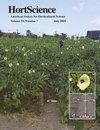Multi-season Evaluation of Substrates for Optimized Arugula and Lettuce Production in Hydroponics
IF 1.5
3区 农林科学
Q2 HORTICULTURE
引用次数: 0
Abstract
Rockwool and peatmoss are commonly used substrates in the greenhouse industry due to their quality, stable pH, exceptional water retention properties and air porosity that is important for plant root development. Although rockwool is commonly used in deep water culture (DWC) hydroponic systems as the base support, there is a lack of studies comparing different types of substrates that could be used in DWC systems, especially considering the increasing market value and awareness of sustainable production in controlled environment agriculture. We identified 13 commercial substrate mixes with different compositions and conducted a series of studies in a DWC system in a greenhouse for three seasons to evaluate their effects on arugula ‘Slow Bolt’ (Eruca sativa L.) and lettuce ‘Summer Crisp’ (Lactuca sativa L.) growth, yield, and quality. The substrates tested significantly influenced the growth, yield, and quality of both arugula and lettuce. The average leaf fresh weight per plant could range from 44 to 190 g for arugula and 89 to 265 g for lettuce. The peat-based products outperformed the coir and other inorganic substrates (phenolic foam, rockwool). The substrate with 75% peat + 25% fine coir produced the greatest plant height, width, and biomass for arugula and lettuce over three growing seasons. Examining arugula and lettuce growth, the fall season produced plants with higher water and nutrient use efficiency, while plants grown during the winter had lower resource use efficiency. Further research is needed to engineer hydroponic substrates suitable for various seasons of leafy green production that results in comparable yield and quality.优化水培芝麻菜和生菜生产的多季基质评估
岩棉和泥炭藓是温室行业常用的基质,因为它们质量上乘、pH 值稳定、保水性能优异,而且气孔率对植物根系发育非常重要。虽然岩棉常用于深水栽培(DWC)水培系统中作为基质支撑,但缺乏对可用于 DWC 系统的不同类型基质进行比较的研究,特别是考虑到可控环境农业的市场价值和可持续生产意识不断提高。我们确定了 13 种不同成分的商用混合基质,并在温室中的 DWC 系统中进行了为期三季的一系列研究,以评估它们对芝麻菜'Slow Bolt'(Eruca sativa L.)和莴苣'Summer Crisp'(Lactuca sativa L.)的生长、产量和质量的影响。测试的基质对芝麻菜和莴苣的生长、产量和质量都有明显影响。芝麻菜的单株平均叶片鲜重从 44 克到 190 克不等,莴苣的单株平均叶片鲜重从 89 克到 265 克不等。泥炭基产品的表现优于椰糠和其他无机基质(酚醛泡沫、岩棉)。在三个生长季中,75% 的泥炭+25% 的细棕壤基质能为芝麻菜和莴苣产生最大的株高、宽度和生物量。从芝麻菜和莴苣的生长情况来看,秋季生长的植株水分和养分利用效率较高,而冬季生长的植株资源利用效率较低。需要开展进一步研究,以设计出适合不同季节绿叶菜生产的水培基质,从而获得可比的产量和质量。
本文章由计算机程序翻译,如有差异,请以英文原文为准。
求助全文
约1分钟内获得全文
求助全文
来源期刊

Hortscience
农林科学-园艺
CiteScore
3.00
自引率
10.50%
发文量
224
审稿时长
3 months
期刊介绍:
HortScience publishes horticultural information of interest to a broad array of horticulturists. Its goals are to apprise horticultural scientists and others interested in horticulture of scientific and industry developments and of significant research, education, or extension findings or methods.
 求助内容:
求助内容: 应助结果提醒方式:
应助结果提醒方式:


